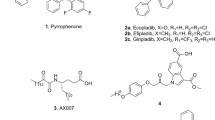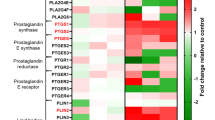Abstract
In this study, we investigated the putative roles of certain protein kinase C (PKC) isoenzymes in the regulation of proliferation and arachidonic acid (AA) release in the human monocytoid MonoMac-6 cell line. Experiments employing specific PKC inhibitors and molecular biological methods (RNA-interference, recombinant overexpression) revealed that the two dominantly expressed isozymes, i.e., the “conventional” cPKCβ and the “novel” nPKCδ, promote AA production and cellular proliferation. In addition, using different phospholipase A2 (PLA2) inhibitors, we were able to show that the calcium-independent iPLA2 as well as diacylglycerol lipase (but not the cytosolic PLA2) function as “downstream” targets of cPKCβ and nPKCδ. In addition, we have also found that, among the other existing PKC isoforms, cPKCα plays a minor inhibitory role, whereas nPKCɛ and aPKCζ apparently do not regulate these cellular processes. In conclusion, in this paper we provide the first evidence that certain PKC isoforms play pivotal, specific, and (at least partly) antagonistic roles in the regulation of AA production and cellular proliferation of human monocytoid MonoMac-6 cells.






Similar content being viewed by others
References
Nishizuka Y (1988) The molecular heterogenity of protein kinase C, and it’s implication for cellular regulation. Nature 334:661–665
Jaken S (1996) Protein kinase C isoenzymes and substrates. Curr Opin Cell Biol 8:168–173
Wilkinson SE, Nixon JS (1998) T-cell signal transduction and the role of protein kinase C. Cell Mol Life Sci 54:1122–1144
Papp H, Czifra G, Bodó E, Lázár J, Kovács I, Aleksza M, Juhász I, Ács P, Sipka S, Kovács L, Blumberg PM, Bíró T (2004) Opposite roles of protein kinase C isoforms in proliferation, differentiation, apoptosis, and tumorigenicity of human HaCaT keratinocytes. Cell Mol Life Sci 61:1095–1105
Dieter P, Schwende H (2000) Protein kinase C-α and -β play antagonistic roles in the differentiation process of THP-1 cells. Cell Signal 12:297–302
Sodhi A, Sedhi G (2005) Role of protein kinase Cδ in UV-B-induced apoptosis of macrophages in vitro. Cell Signal 17:377–383
Silberman DM, Zorrilla-Zubilete M, Cremaschi GA, Genaro AM (2005) Protein kinase C-dependent NF-κB activation is altered in T cells by chronic stress. Cell Mol Life Sci 62:1744–1754
Akiba S, Ohno S. Chiba M, Kume K, Hayama M, Sato T (2002) Protein kinase Cα-dependent increase in Ca2+-independent phospholipase A2 in membranes and arachidonic acid liberation in zymosan-stimulated macrophage-like P388D1 cells. Biochem Pharmacol 63:1969–1977
Hii CS, Huang ZH, Bilney A, Costabile M, Murray AW, Rathjen DA, Der CJ, Ferrante A (1998) Stimulation of p38 phosphorylation and activity by arachidonic acid in HeLa cells, HL60 promyelocytic leukemic cells, and human neutrophils. Evidence for cell type-specific activation of mitogen-activated protein kinases. J Biol Chem 273:19277–19282
Todt JC, Hu B, Punturieri A, Sonstein J, Polak T, Curtis JL (2002) Activation of protein kinase CβII by the stereo-specific phosphatidylserine receptor is required for phagocytosis of apoptotic thymocytes by resident murine tissue macrophages. J Biol Chem 277:35906–35914
Haeggstrom JZ, Wetterholm A (2002) Enzymes and receptors in the leukotriene cascade. Cell Mol Life Sci 59:742–753
Di Marzo V, Vial D, Sokoloff P, Schwartz JC, Piomelli D (1993) Selection of alternative G-mediated signaling pathways at the dopamine D2 receptor by protein kinase C. J Neurosci 11:4846–4853
Manicassamy S, Gupta S, Huang Z, Sun Z (2006) Protein kinase C-θ-mediated signals enhance CD4+ T cell survival by up-regulating Bcl-xL. J Immunol 176(11):6709–6716
Meller N, Elitzur Y, Isakov N (1999) Protein kinase C-θ (PKCθ) distribution analysis in hematopoietic cells: proliferating T cells exhibit high proportions of PKCθ in the particulate fraction. Cell Immunol 193(2):185–193
Lucas PC, McAllister-Lucas LM, Nunez G (2004) NF-κB signaling in lymphocytes: a new cast of characters. J Cell Sci 117(Pt 1):31–39
Martin P, Duran A, Minguet S, Gaspar ML, Diaz-Meco MT, Rennert P, Leitges M, Moscat J (2002) Role of ζPKC in B-cell signaling and function. EMBO J 21(15):4049–4057
Bíró T, Griger Z, Kiss E, Papp H, Aleksza M, Kovacs I, Zeher M, Bodolay E, Csepany T, Szucs K, Gergely P, Kovacs L, Szegedi G, Sipka S (2004) Abnormal cell-specific expressions of certain protein kinase C isoenzymes in peripheral mononuclear cells of patients with systemic lupus erythematosus: effect of corticosteroid application. Scand J Immunol 60:421–428
Sipka S, Szántó S, Szűcs K, Kovács I, Kiss E, Antal-Szalmás P, Lakos G, Aleksza M, Illés Á, Gergely P, Szegedi G (2001) Decreased arachidonic acid release in peripheral blood monocytes of patients with systemic lupus erythematosus. J Rheumatol 28:2012–2017
Martiny-Baron G, Kazanietz MG, Mischak H, Blumberg PM, Kochs G, Hug H, Marme D, Schachtele C (1993) Selective inhibition of protein kinase C isozymes by the indolocarbazole Gö 6976. J Biol Chem 268:9194–9197
Gschwendt M, Müller HJ, Kialbassa K, Zang R, Kittstein W, Rincke G, Marks F (1994) Rottlerin, a novel protein kinase inhibitor. Biochem Biophys Res Commun 199:93–98
Davies SP, Reddy H, Caivano M, Cohen P (2000) Specificity and mechanism of action of some commonly used protein kinase inhibitors. Biochem J 351:95–105
Soltoff SP (2001) Rottlerin is a mitochondrial uncoupler that decreases cellular ATP levels and indirectly blocks protein kinase C6 tyrosine phosphorylation. J Biol Chem 276:37986–37992
Kayali AG, Austin DA, Webster NJ (2002) Rottlerin inhibits insulin-stimulated glucose transport in 3T3-L1 adipocytes by uncoupling mitochondrial oxidative phosphorylation. Endocrinology 143:3884–3896
Tapia JA, Jensen RT, Garcia-Marin LJ (2006) Rottlerin inhibits stimulated enzymatic secretion and several intracellular signaling transduction pathways in pancreatic acinar cells by a non-PKC-δ-dependent mechanism. Biochim Biophys Acta 1763:25–38
Smith WL, DeWitt DL, Garavito RM (2000) Cyclooxygenases: structural, cellular, and molecular biology. Annu Rev Biochem 69:145–182
Balsinde J, Winstead MV, Dennis EA (2002) Phospholipase A2 regulation of arachidonic acid mobilization. FEBS Lett 531:2–6
Karimi K, Lennartz MR (1995) Protein kinase C activation precedes arachidonic acid release during IgG-mediated phagocytosis. J Immunol 155:5786–5794
Lin WW, Chen BC (1998) Distinct PKC isoforms mediate the activation of cPLA2 and adenylyl cyclase by phorbol ester in RAW264.7 macrophages. Br J Pharmacol 125:1601–1609
Guidarelli A, Cerioni L, Tommasini I, Brune B, Cantoni O (2005) A downstream role for protein kinase Cα in the cytosolic phospholipase A2-dependent protective signalling mediated by peroxynitrite in U937 cells. Biochem Pharmacol 69:1275–1286
Martel MA, Patenaude C, Menard C, Alaux S, Cummings BS, Massicotte G (2006) A novel role for calcium-independent phospholipase A in α-amino-3-hydroxy-5-methylisoxazole-propionate receptor regulation during long-term potentiation. Eur J Neurosci 23:505–513
Ackermann EJ, Conde-Frieboes K, Dennis EA (1995) Inhibition of macrophage Ca2+-independent phospholipase A2 by bromoenol lactone and trifluoromethyl ketones. J Biol Chem 270:445–450
Lin WW, Chang SH, Wu ML (1998) Lipoxygenase metabolites as mediators of UTP-induced intracellular acidification in mouse RAW 264.7 macrophages. Mol Pharmacol 53:313–321
Murray NR, Baumgardner GP, Burns DJ, Fields AP (1993) Protein kinase C isotypes in human erythroleukaemia (K562) cell proliferation and differentiation. Evidence that βII protein kinase C is required for proliferation. J Biol Chem 268:15847–15853
Bisogno T, Howell F, Williams G, Minassi A, Cascio MG, Ligresti A, Matias I, Schiano-Moriello A, Paul P, Williams EJ, Gangadharan U, Hobbs C, Di Marzo V, Doherty P (2003) Cloning of the first sn1-DAG lipases points to the spatial and temporal regulation of endocannabinoid signaling in the brain. J Cell Biol 163(3):463–468
Bisogno T, Cascio MG, Saha B, Mahadevan A, Urbani P, Minassi A, Appendino G, Saturnino C, Martin B, Razdan R, Di Marzo V (2006) Development of the first potent and specific inhibitors of endocannabinoid biosynthesis. Biochim Biophys Acta 1761(2):205–212
Mischak H, Pierce JH, Goodnight J, Kazanietz MG, Blumberg PM, Mushinski JF (1993) Phorbol ester-induced myeloid differentiation is mediated by protein kinase C-α and -δ and not by protein kinase C-βII, -ɛ, -ζ, and -η. J Biol Chem 268:20110–20115
Acknowledgments
This work was supported by Hungarian Research grants: OTKA T37531, OTKA T049231, OTKA K63153, NKFP 1A/008/04, RET 06/2004. The authors declare no competing financial interests.
Author information
Authors and Affiliations
Corresponding author
Rights and permissions
About this article
Cite this article
Griger, Z., Páyer, E., Kovács, I. et al. Protein kinase C-β and -δ isoenzymes promote arachidonic acid production and proliferation of MonoMac-6 cells. J Mol Med 85, 1031–1042 (2007). https://doi.org/10.1007/s00109-007-0209-y
Received:
Revised:
Accepted:
Published:
Issue Date:
DOI: https://doi.org/10.1007/s00109-007-0209-y




